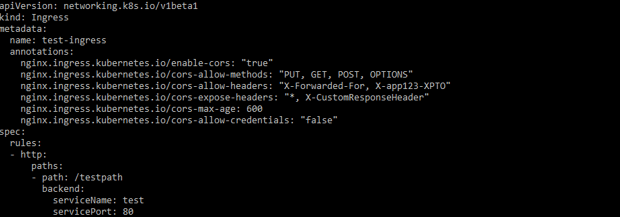
For example /permanent-redirect-code: ‘308’ would return your permanent-redirect with a 308.

#NGINX INGRESS ANNOTATIONS CODE#
This annotation allows you to modify the status code used for permanent redirects. For example /permanent-redirect: would redirect everything to Google. This annotation allows to return a permanent redirect instead of sending data to the upstream. In the resulting nf an if statement will be added to the server context : if ($uri = /) Īdditional docs: annotations.md#permanent-redirect and here. This one is nice: defines the Application Root that the Controller must redirect if it’s in / context: $ echo " apiVersion: extensions/v1beta1 kind: Ingress metadata: annotations: /app-root: /destination name: approot namespace: default spec: rules: - host: http: paths: - backend: serviceName: http-svc servicePort: 80 path: / " | kubectl create -f. I assume this can be used using /configuration-snippet: | (I have not tried it yet). If you need to control the return code using a rewrite rule, then you need to use a return directive after the rewrite directive. If a directive is specified inside the location, further processing of the request continues in this location. Rewrite “(?i)/source(/|$)(.*)” /destination$1$2 break Syntax: break Default: - Context: server, location, if Stops processing the current set of ngx_http_rewrite_module directives. Using /permanent-redirect-code: ‘308’annotation has no effect on the code returned as this is controlled by the rewrite rule in nf. If a replacement string starts with “ “ or “$scheme”, the processing stops and the redirect is returned to a client. It is possible to terminate further processing of the directives using flags. The rewrite directives are executed sequentially in order of their appearance in the configuration file. If the specified regular expression matches a request URI, URI is changed as specified in the replacement string.

Such a parameter should start with the “ “ or “$scheme” string. From nginx docs: In addition, a URL for temporary redirect with the code 302 can be specified as the sole parameter. This is because the replacement string as specified in rewrite-target annotation starts with. This one changes the Location header and the URL in the browser is updated: HTTP/1.1 302 Moved Temporarily curl -I /source Location: HTTP/1.1 302 Moved Temporarily curl -I /source/bar Location: bar
#NGINX INGRESS ANNOTATIONS UPDATE#
It does not update the Location header so the URL in the browser does not change.Įxample 2: apiVersion: /v1beta1 kind: Ingress metadata: annotations: kubernetes.io/ingress.class: "nginx" /rewrite-target: /destination $1$2 name: destination-home namespace: myNamespace spec: rules: - host: nginx.redirect http: paths: - backend: serviceName: http-svc servicePort: 80 path: /source(/|$)(.*) This one does a transparent reverse proxy. If the pods of the primary controller are not available, the traffic is routed to the backup one Ĭaution! There can be only one controller with this inlet type on a host.Ĭaution! The following ports must be available on the node: 80, 81, 443, 444, 10354, 10355.Īllowed values: LoadBalancer, LoadBalancerWithProxyProtocol, HostPort, HostPortWithProxyProtocol, HostWithFailoverExample 1: apiVersion: /v1beta1 kind: Ingress metadata: annotations: kubernetes.io/ingress.class: "nginx" /rewrite-target: /destination$1$2 name: destination-home namespace: myNamespace spec: rules: - host: nginx.redirect http: paths: - backend: serviceName: http-svc servicePort: 80 path: /source(/|$)(.*)

The primary controller runs in a hostNetwork. HostWithFailover - installs two ingress controllers, the primary and the backup one. The acceptRequestsFrom parameter can help you with defining trusted sources. HostPortWithProxyProtocol - Ingress controller is deployed and available through nodes’ ports via `hostPort, it uses proxy-protocol to get a real IP of the client.Ĭaution! Make sure that requests to the Ingress are sent from trusted sources when using this inlet. HostPort - Ingress controller is deployed and available through nodes’ ports via hostPort.Ingress controller uses proxy-protocol to get a real IP of the client.

LoadBalancerWithProxyProtocol - Ingress controller is deployed and the service of LoadBalancer type is provisioned.LoadBalancer - Ingress controller is deployed and the service of LoadBalancer type is provisioned.The way traffic goes to cluster from the outer network.


 0 kommentar(er)
0 kommentar(er)
